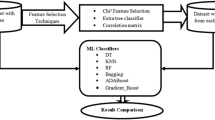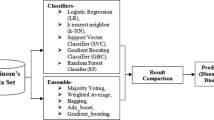Abstract
PD is a neurodegenerative disorder of the nervous system, of unknown cause and chronic, progressive and irreversible course. According to the World Health Organization, Parkinson’s is the second most common neurodegenerative disease after Alzheimer’s disease. This is one of the diseases that has the greatest impact on the lives of people who suffer from it, as well as their families, since it affects all the satisfaction of basic needs and presents situations of dependency and disability. In order to develop tools for early diagnosis of PD, data analysis was performed using feature selection and classification methods such as Random Forest, Logistic Regression, and Support Vector Machine. In the test stage, the SVM model with 0.8927 area under the curve obtained the best performance, followed by the RF method with 0.8899 and finally the LR model with 0.8574. The specificity and sensitivity in the three models remain above 0.75. Regardless of the model performed, models that have been trained and tested with the 17 selected functions improve performance considerably, compared to other investigations.
Access this chapter
Tax calculation will be finalised at checkout
Purchases are for personal use only
Similar content being viewed by others
References
Ahmad, I., Yousaf, M., Yousaf, S., Ahmad, M.O.: Fake news detection using machine learning ensemble methods. Complexity 2020 (2020). https://doi.org/10.1155/2020/8885861
Alotaibi, F.S.: Implementation of machine learning model to predict heart failure disease. Int. J. Adv. Comput. Sci. Appl. 10(6) (2019)
Armstrong, M.J., Okun, M.S.: Diagnosis and treatment of parkinson disease: a review. Jama 323(6), 548–560 (2020). https://doi.org/10.1001/jama.2019.22360
Blauwendraat, C., Nalls, M.A., Singleton, A.B.: The genetic architecture of parkinson’s disease, February 2020. https://doi.org/10.1016/S1474-4422(19)30287-X
Concepción, G.M.M., Lourdes, J.N.M., Esther, B., María, N.M., de Perosanz Calleja María: Enfermedad de parkinson: abordaje enfermero desde atención primaria. GeroKomos (2018)
Dhal, P., Azad, C.: A comprehensive survey on feature selection in the various fields of machine learning. Appl. Intell. 1–39 (2021). https://doi.org/10.1007/s10489-021-02550-9
Holzinger, A., Langs, G., Denk, H., Zatloukal, K., Müller, H.: Causability and explainability of artificial intelligence in medicine, July 2019. https://doi.org/10.1002/widm.1312
Joshi, R.D., Dhakal, C.K.: Predicting type 2 diabetes using logistic regression and machine learning approaches. Int. J. Environ. Res. Public Health 18 (2021). https://doi.org/10.3390/ijerph18147346
Kohli, P.S., Arora, S.: Application of machine learning in disease prediction. In: 2018 4th International Conference on Computing Communication and Automation (ICCCA), pp. 1–4. IEEE (2018)
Porter, D.: Balancing contested meanings of creativity and pathology in parkinson’s disease. Balancing the self 286–313 (2020)
Rawat, C.S., Pandey, S.: Parkinson’s disease–an introduction. In: Arjunan, S.P., Kumar, D.K. (eds.) Techniques for Assessment of Parkinsonism for Diagnosis and Rehabilitation. SB, pp. 1–24. Springer, Singapore (2022). https://doi.org/10.1007/978-981-16-3056-9_1
Sakar, C.O., et al.: A comparative analysis of speech signal processing algorithms for parkinson’s disease classification and the use of the tunable q-factor wavelet transform. Appl. Soft Comput. J. 74, 255–263 (2018). https://doi.org/10.1016/j.asoc.2018.10.022
Speiser, J.L., Miller, M.E., Tooze, J., Ip, E.: A comparison of random forest variable selection methods for classification prediction modeling, November 2019. https://doi.org/10.1016/j.eswa.2019.05.028
Trevino, V., Falciani, F.: Galgo: An r package for multivariate variable selection using genetic algorithms. Bioinformatics 22, 1154–1156 (2006). https://doi.org/10.1093/bioinformatics/btl074
Zesiewicz, T.A.: Parkinson disease. CONTINUUM: Lifelong Learn. Neurol. 25(4), 896–918 (2019)
Author information
Authors and Affiliations
Corresponding author
Editor information
Editors and Affiliations
Rights and permissions
Copyright information
© 2023 The Author(s), under exclusive license to Springer Nature Switzerland AG
About this paper
Cite this paper
Villagrana-Bañuelos, R., Villagrana-Bañuelos, K.E., Murillo, M.A.S., Galván-Tejada, C.E., Celaya-Padilla, J.M., Galván-Tejada, J.I. (2023). Comparison of Three Supervised Machine Learning Classification Methods for the Diagnosis of PD. In: Bravo, J., Ochoa, S., Favela, J. (eds) Proceedings of the International Conference on Ubiquitous Computing & Ambient Intelligence (UCAmI 2022). UCAmI 2022. Lecture Notes in Networks and Systems, vol 594. Springer, Cham. https://doi.org/10.1007/978-3-031-21333-5_31
Download citation
DOI: https://doi.org/10.1007/978-3-031-21333-5_31
Published:
Publisher Name: Springer, Cham
Print ISBN: 978-3-031-21332-8
Online ISBN: 978-3-031-21333-5
eBook Packages: Intelligent Technologies and RoboticsIntelligent Technologies and Robotics (R0)




